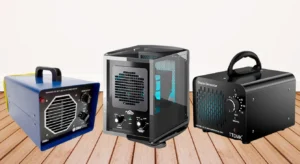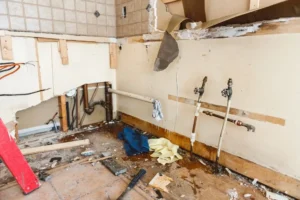Noticing a water bubble in your ceiling can be alarming. At RestoTek, we know that even a small bubble is a warning sign that moisture has found its way into your home. Whether the issue stems from a roof leak, faulty flashing, or a plumbing problem, a water bubble demands immediate attention.
In this blog, we’ll be talking about what a water bubble means, cover the immediate actions you should take, and discuss long-term solutions to prevent further damage. Our goal is to help you understand the risks and empower you to protect your home from escalating water damage.
What Causes Water Bubbles in My Ceiling?
A water bubble in your ceiling is an unmistakable sign that moisture has penetrated the structure. This occurs when water seeps through compromised areas, causing the ceiling material to bulge. It serves as an early indicator that your home’s protective barrier has been breached, which, if ignored, can lead to more extensive damage.
In many cases, the culprit behind the bubble is a roof leak caused by missing or damaged shingles. Other possibilities include deteriorated flashing, clogged gutters, or even plumbing leaks from an upstairs bathroom.
Not only that, but condensation from inadequate insulation may also be responsible. Each of these factors can allow water to accumulate and compromise your ceiling. If left unchecked, the moisture can foster mold growth, weaken structural integrity, and ultimately lead to costly repairs.
There’s Water in My Ceiling What Should I Do?
#1 – Safety First
If you notice a water bubble in your ceiling, your first step is to ensure safety. Check for any signs of electrical hazards—if water is near outlets or light fixtures, avoid touching them. Be cautious when accessing the affected area, and consider turning off power in the room until a professional assessment is completed.
#2 Get Temporary Measures In Place
Next, take steps to minimize further damage. If possible, locate and shut off any nearby water sources contributing to the leak. Place a bucket or container under the affected area to catch any drips. Cover the bubble with a tarp or plastic sheeting to prevent additional water from penetrating the ceiling. These temporary fixes can help stabilize the situation until professional help is available.
#3 – Document Everything You Can
Before repairs begin, it is crucial to document the damage. Take clear photos and note the time and date when you first noticed the issue. This documentation can be invaluable for insurance claims and helps our team at RestoTek develop an accurate repair plan tailored to your home’s needs.
Long-Term Solutions & Ongoing Preventative Maintenance Are Crucial
Once the immediate danger is addressed, schedule a professional inspection with RestoTek. Our experts will assess the source of the water intrusion and determine whether the issue lies with the roof, plumbing, or other areas.
A comprehensive evaluation is critical to developing an effective repair strategy that not only fixes the current damage but also prevents future issues. Based on our findings, permanent repairs may involve replacing missing shingles, repairing damaged flashing, or addressing plumbing leaks.
Long-term prevention is essential. We recommend routine inspections and regular maintenance of your roof, gutters, and plumbing systems. By keeping these systems in optimal condition, you reduce the likelihood of future water intrusion. Our preventative maintenance plans are designed to catch potential issues early, ensuring your home remains secure and dry for years to come.
Partner With the Leading Texas Water Damage Restoration Experts
A water bubble in your ceiling is a clear warning sign that immediate action is needed. Ignoring this issue can lead to mold growth, structural damage, and high repair costs. Let our skilled team help protect your home from further water damage. Contact RestoTek today for a comprehensive inspection and lasting repairs.



